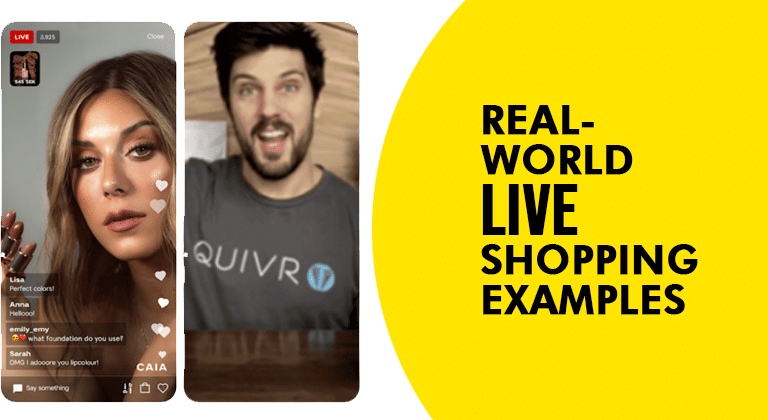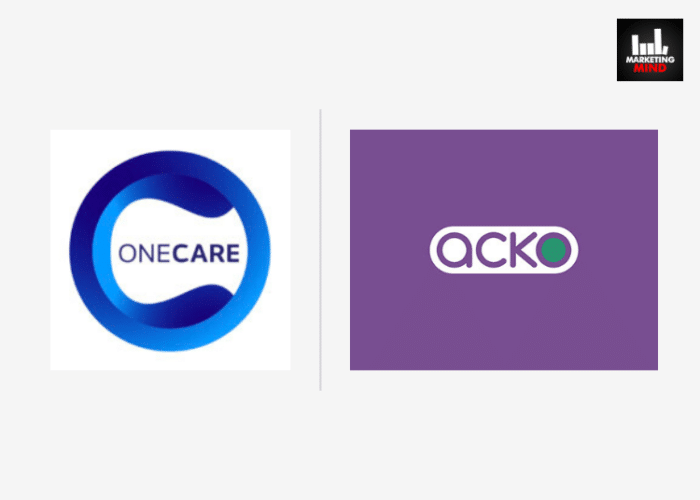Around the world, live shopping is causing a stir. Introducing to you the best live brand-hosted shopping experiences.
Live stream shopping is becoming more well-known in the video e-commerce world, and this year has already provided us with many exciting examples. There is no doubt that the viewer is excited by the uniqueness of the real-time buying experience and is compelled to make an impulsive purchase.
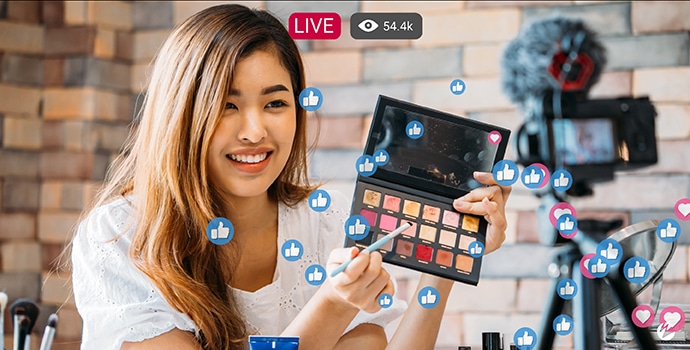
What is the meaning of Live Stream Shopping?
A host, who is frequently a celebrity or influencer, promotes items live on camera as part of the e-commerce marketing technique known as livestream shopping.
It’s also known as “live shopping,” and it’s essentially the home shopping channel of the twenty-first century. However, with so much activity occurring on digital platforms, there are now far more options for involvement and connection.
You have undoubtedly read about livestream shopping being the “next big thing” if you have ever read anything about it. It’s already quite popular in Asia; according to a 2020 poll, two-thirds of Chinese customers bought live streams the year before. And in the US, where Coresight Research predicts the “live streaming e-commerce market” will reach $25 billion in value by 2023, it is gaining popularity quickly.
This article will analyse a few more of the most stunning shoppable live streams to appear on the internet in recent months.
What brands make advantage of live streaming?
In an effort to promote business expansion, a number of brands in the retail, cosmetics, food and beverage, and other industries have used livestream shopping on various platforms.
Let’s examine a few instances of real-world businesses who designed successful and pertinent livestream shopping events and they are as follows:
Livestreaming Campaign for NYX with Pop Stars

One of the first companies to advocate livestream shopping was NYX Cosmetics.
By inviting early 2000s pop stars like Lance Bass, Brandy, and JoJo to revive looks from the previous ten years for its throwback event on Triller, it sparked the nostalgia of the audience.
Without really spending money on advertising, the company managed to connect with its audience by experimenting with the cutting-edge idea of shoppable films on a live-streaming selling platform. The ad was effectively targeted at the target market, which comprised millennials and members of Generation Z. These individuals were led to the appropriate purchase site on the NYX webpage.
Tap Into Complementary Audiences with Aldo

When brands involve their favorite celebrities or personalities who motivate consumers’ purchases, connecting with the audience becomes easier. Aldo accomplished this by enlisting the help of TikTok celebrity Nate Wyatt and celebrity stylist Mini Cuttrell through live-streaming.
While the brand displayed its collection in real-time, the audience witnessed their favorite influencers brilliantly promoting the brand. With a more than 300% engagement rate and a total watch time of 12 minutes, the results were astounding.
Petco the Ideal Livestream Campaign

The 1980s’ dearth of alternative entertainment choices contributed in part to the success of home shopping channels. They were almost certainly assured a captive audience because there were only a few dozen other channels available to contend with.
The retail pet retailer Petco held a dog adoption campaign in addition to a fashion display for pets. The ‘The Perfect Fit’ event was streamed live on Facebook and generated more revenue than was expended on planning it.
In contrast to typical live streams, the audience was ready for pure amusement as they saw canines take the ramp in style. Due to this, more than a million viewers watched the live stream, and all the dogs included in the fashion show were adopted.
JCPenney Live Shopping: The event’s theme (& Host)

JCPenny has tapped into the potential of real-time online purchasing by streaming live the sale of its Christmas goods on Facebook, and YouTube, as well as its e-commerce website. The show, dubbed “JCP Live,” provides a cataloged buying experience for the brand’s newest holiday goods.
Each episode’s theme-based section has a rotating cast of influencers who share their knowledge on a variety of subjects, including family fun, cutting-edge technology, warm comfort, health and wellbeing, and last-minute Christmas shopping.
Due to the opportunity for viewers to interact, ask a question, and even win gift cards during the programme, engagement during these live streams soars.
CAIA Cosmetic Livestream Shopping Platform: Set Clear Goals
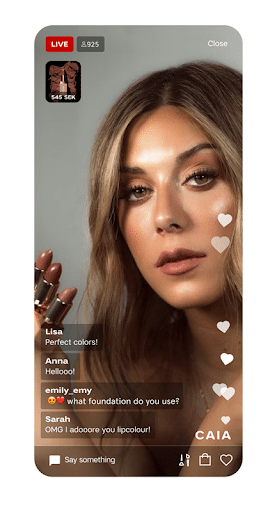
In 2019, the Swedish cosmetics business CAIA joined the market for livestream shopping platforms.
Conversion rates for the company’s initial livestream were 5%, which was much higher than those for its website generally. Since then, there has been no going back as the business keeps producing livestream purchasing experiences that engage its audience.
The creator of CAIA, Bianca Ingrosso, hosts the company’s live lessons, which have an average watching length of 11 minutes and a 60% “like” rate, according to mobile streaming software provider Bambuser.
Walmart’s Short-Video Streaming Platform

Walmart launched their first live-streaming shopping event in collaboration with the short-form video sharing service TikTok. The “Holiday Shop-Along Spectacular” event put their holiday-specific items front and centre while giving customers an in-app first-hand experience.
Following its popularity, Walmart has continued to offer these televised purchasing events for its devoted clientele.
Walmart hosted 15 events and collaborated with 20 well-known content producers in the first year of its virtual shopping outreach. 30 shoppable livestreams were launched as part of the anniversary event and continued all across the holiday season. Rachel Ray, Drew Barrymore and Ree Drummond from The Pioneer Woman were among the other famous hosts for the year-end series.
KitKat Chocolate Australia: Integrate Live Shopping Into Your Broader Marketing Plan
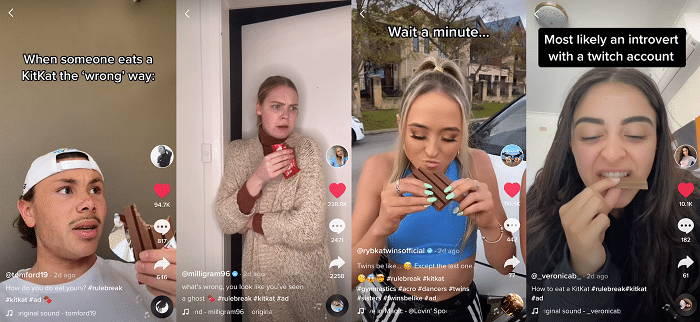
Livestream purchasing probably won’t be your only kind of advertising. For the best outcomes, it must complement your overarching plan; otherwise, you run the danger of wasting time and money by deviating from what is effective.
KitKat showed how a livestream buying event may be an ideal fit for a social media advertising campaign to increase online sales and foot traffic to Melbourne and Sydney physical shops.
Branded content, interactive adverts, and surveys persuaded customers to make online or in-person purchases. The same day, a Facebook livestream advised viewers to use Click to Message, which starts Facebook Messenger chats from stream comments, to make purchases.
Nordstrom Has Its Own Live Shopping Channel: Don’t Forget Your Content Strategy

Nordstrom was among the first livestream shopping corporations to launch a unique live shopping channel.
Numerous live shopping events are held on the channel each week around popular topics including spring and fall fashion. A “static” content piece (like a blog article) would never allow for asking visitors questions and getting their replies in real-time, but Nordstrom makes such topics more interesting by placing them in the framework of live shopping.
The channel has since held many live shopping sessions with themes like:
1. Amazing skincare techniques
2. Simple and quick holiday gifts
3. Holiday makeover
livestream shopping, Quivr sales increased by 150%- Choose Your Platform Wisesly

Quivr will begin testing broadcast shopping systems in 2020. The founder spent an hour discussing the Quivr brand’s history and its goods with the audience of 50 people.
The session received positive feedback from the public, and the company has subsequently hosted countless further livestream shopping events. The brand frequently experiences a 150% increase in sales over the course of the next 24 hours as a result of the livestream’s popularity and audience reach.
According to co-founder Ash Crawford, Amazon prevailed because, in his opinion, its audience is more qualified than those of other platforms. People are typically in the mood to make purchases when they visit Amazon, as opposed to Instagram and TikTok, which are more regarding entertainment.
Wrap Up
As livestream shopping becomes popularity, we’ll see more and more companies convert their own platforms into livestream shopping portals. Brands will have greater power as a result to strategically plan and create their livestreams, making sure to pay close attention to the behaviour of their audience.
Brands with convenient access to the first data may learn what their audience is responding to and plan out subsequent livestreams appropriately.
Customers are in for a treat as the eCommerce industry develops into this highly interactive buying experience.
WANT TO KNOW MORE?





